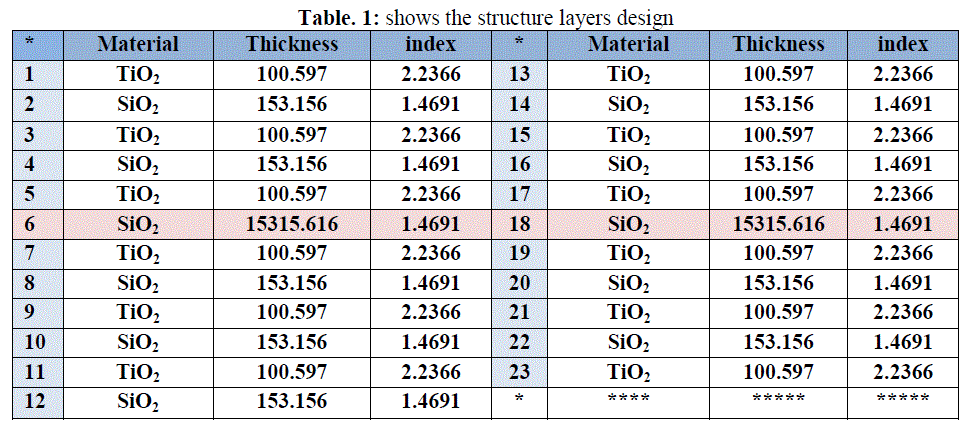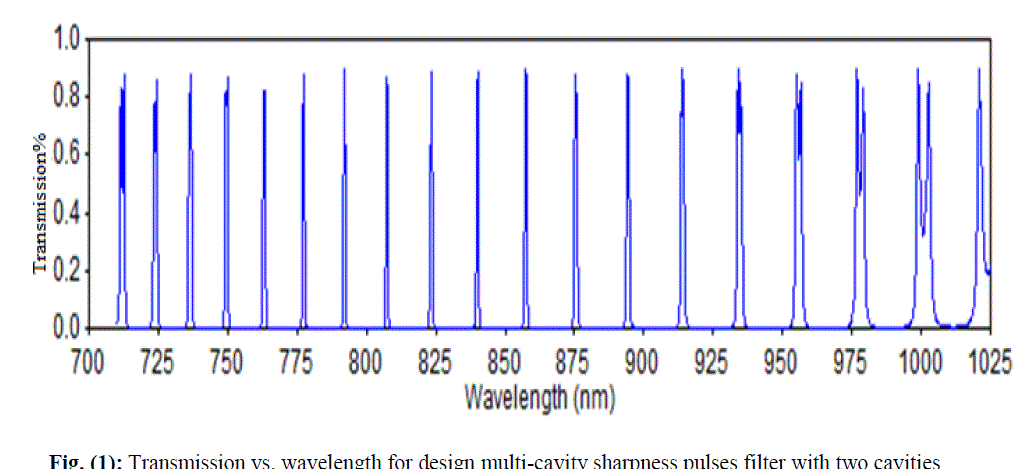ISSN ONLINE(2319-8753)PRINT(2347-6710)
ISSN ONLINE(2319-8753)PRINT(2347-6710)
| Amer B.Dheyab, Gaillan H. Abdullah, Ali Hassan and Haider Y. Hammod Ministry of science and technology/Directorate of material Research /center of laser research |
| Related article at Pubmed, Scholar Google |
Visit for more related articles at International Journal of Innovative Research in Science, Engineering and Technology
We present design thin film multi-cavity sharpness pulses applied in communications Field. These filters are most widely used filtration technologies that made possible technical advancement of modern optical communication system.This paper is concerned with a theoretical study on optoelectronics physics to design and analyze this type of filter. A brief introduction to the thin film sharpness pulses applied in communications Field. Technology will be presented. The recent progress in design thin film multi-cavity technology will be reviewed. These designs consist of two material TiO2 / SiO2 as high / low index. The wavelength range 710 - 1025nm and detecting number of channels (20channels) at different wavelengths. The filter is to be coated on substrate Fused Silica having index 1.55 and the design operates at incident angle (450).
Keywords |
| Multi-cavity, thin film, optical communication, coating |
INTRODUCTION |
| In current optical communication systems multilayer thin-film coatings find application in many functions such as antireflection coatings, wavelength division multiplexing (WDM) filters, interleaves, band splitting filters, or gain flattening filters. The fabrication of thin-film coatings is a proven technology and packaging technology has improved significantly in recent years [1-4]. A wide range of synthesis approaches is available to design multilayer coatings even with complex reflection and transmission profiles such as gain equalizing filters for erbium-doped fiber amplifiers (EDFAs) [1- 6]. Recently, emphasis has been given to designing coatings with a decreased sensitivity to fabrication errors allowing a higher yield [7, 8]. Progress has also been made in thermo-optic and electro-optic tuning of thin-film filters [9- 11]. In the following we will focus on the dispersive properties of thin-film coatings, since these gain importance in the design of filters for dense wavelength division multiplexing (DWDM) systems and are promising for novel multiplexing/ demultiplexing and dispersion-compensation components. Thin film multi-cavity sharpness pulses applied in communications Field are widely used in wavelength division multiplexing (WDM) applications in fiber optic communication systems. These filters must have sharp cut-on and cut- off on either side of the sharpness pulses and practically zero transmittance outside the sharpness pulses, over the wavelength range of the applications. Wavelength division multiplexing (WDM) is an integral component of fiber optic communication systems and enables several channels of information to be encoded on light signals of different wavelengths and transmitted simultaneously over the same optical fiber, to separated and decoded at the receiving end [12]. |
THEORY |
| The basic structure of thin film multi-cavity sharpness pulses applied in communications field is a multilayer stack of alternately high index and low index thin films, most of which are one-quarter wave thick at the design wavelength, deposited on an ophthalmic glass or silica substrate'. TiO2 is chosen as the high index material and SiO2 as the low index material in most multilayer stacks because of the superior material properties and mutual compatibility of these materials. The calculated transmittance characteristics of a multi-cavity multilayer stack, with different spacer layer thicknesses and different numbers of layers in the end reflector and coupling reflector stacks, transmittance characteristics of the multilayer stack: |
 |
| With the high index (TiO2) and low index (SiO2) layers being one quarter wave thick at 900 nm. The technology of DWDM is one of the most recent and important technique in the development of fiber optic communication technology. In the following section we briefly describe the stages of fiber optic technology and the place of DWDM in the development. The reality of fiber optic communication had been proven in the nineteenth century, but the technology began to advance rapidly in the late of the twentieth century. After the probability of transmitting light in fiber had been established, it was known that light has an information- carrying capacity of 10,000 times greater than the highest radio frequencies. Besides, the additional advantages of fiber optic communication over copper wire include the ability to carry signals over long distances, low error rates, immunity to electrical interference, security, and light weight. Multiplexing and demultiplexing functions both employ sharpness pulses applied in communications Field, cascaded and combined in other ways to achieve the desired result. A different technology uses interference filters in devices called thin interference filters. Thin-film filters consist of a number of alternate layers of transparent dielectric mate of high and low refractive indices deposited sequentially on an optical substrate. The stack of thin films can be made using one of the coating technologies, such as plasma deposition, and ion assisted deposit long stability, and small losses of chromatic dispersion and polarization system, a thin-film filter would only transmit the wavelength of the optical chant he filter and would reflect all others in the DWDM signal. the theory and/or the proposed method band-pass filter is constructed on the Fabry wavelength, deposited on an ophthalmic glass or silica probability of transmitting light in fiber had been established, it information-carrying capacity of 10,000 times greater than the highest radio prism. Thinfilm filters so multilayer plasma-assisted deposition, ion beam sputtering deposition (IAD). Thin-film filters exhibit a very low temperature coefficient, polarization-related dispersion. In DWDM channel which was designed for the filter and would reflect all others in the DWDM signal. Now we can use the heuristic model equation (1) for the maximum shift to estimate the maximum number of channels given the refractive indices of the two materials used, the stack thickness, the incidence angle, the polarization, and the operating wavelength. Account is the number of channels through the equation below: |
 |
| (nH=2.2366) on a Fused Silica substrate (ns=1.55), L = 33216.8 nm, crosstalk of –40dB)[14]. A 20-channel demultiplexing has been demonstrated theoretic using open filter. [15]. It is interesting to note that the number of channels scales as the thickness divided by the wavelength. just as we would expect. In this model the thickness not the number of layers seems to matter. That is not correct though, since the layer thickness should be on the order of a quarter wavelengths. Therefore, fixing a stack thickness also fixes the number of layers needed. Finally, let us consider the design question posed at the beginning Can we design a structure that demultiplexes 100 channels, changing to a larger incidence angle could also help to obtain more channels. |
DESIGN AND DISCUSSION |
| In the present work, these theoretical designs have been suggested and their profiles have been fully studied for the visible region and near IR region using open filter software [13]. The technology of DWDM is one of the most recent and important technique in the development of fiber optic communication technology.The sharpness pulses filter used for detecting light at different wavelengths as in design below. Between these wavelengths the filter is as in Fig.1 the filter is to be coated on Fused Silica having index 1.55. The filter operates at incidence angle 45º. The most common structure for sharpness pulses applied in communications field, consisting of dielectric filter with quarter-wave optical thick layers for the layers and half-wave optical thick, or multiple half-wave optical thick layers for the spacers. So that the open filter program can be used to design this filter. Table.1 shows the data for the design. |
 |
| We see from Fig.1 that the transmittance remains close to zero (actually below 0.1%) over a range of710-1025 nm on either side of each Centre wavelengths or sharpness pulses. The wavelength range from 710- 1025nm and detecting maximum number of channels (20) using equation (1) at incident angle 45º. The filter is to be coated on Fused Silica having index 1.55, we can see from Fig.1 that 20-channels at different wavelengths which are (711, 723, 735, 748, 762, 776, 791, 806, 822, 838, 855, 876, 892, 912, 932, 953, 977, 997, 1003, 1022) nm |
 |
CONCLUSIONS |
| From the results above we can conclude that Multilayer thin-film coatings are a proven technology that is employed in many areas of optical communication systems. New developments include the design of filters with a higher tolerance towards fabrication errors, tunable filters, and dispersive filters for dispersion compensation and wavelength multiplexing and demultiplexing. The goal of this talk is to give an overview of how design study thin film multi-cavity sharpness pulses applied in communications Field., where optical thin film filters fit in, and what it takes to make them applications of multi-cavity filters such as space-based laser communication systems, spectral radiometry, medical diagnostics, chemical analysis colorimetry, environmental monitoring, security systems, avionics, space and ground base telescopes, and others. |
References |
|